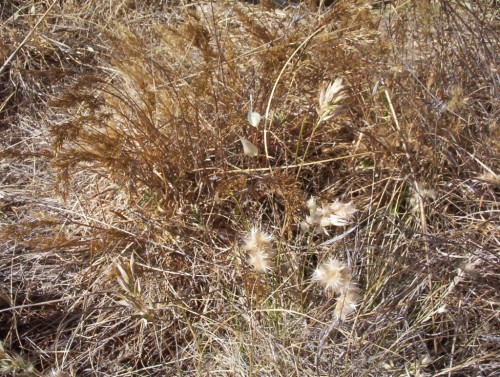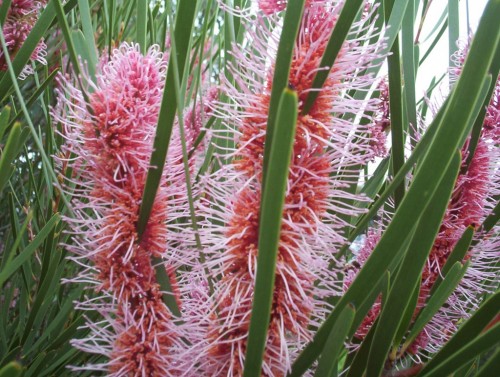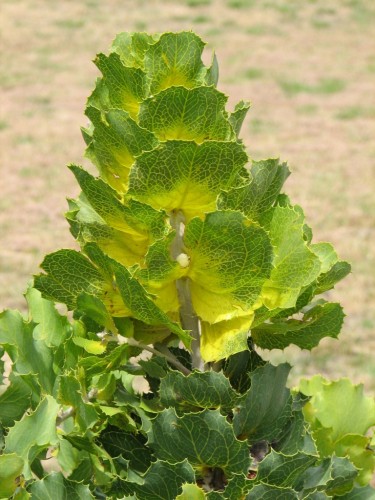Using Australian Native Grasses As Lawn
The suggestion was made that it would be worth trying Wallaby Grass (Austrodanthonia setacea) and Weeping Rice Grass (Microlaena stipoides) together in a lawn and that both would accept foot traffic. They would need to be watered probably every three weeks during late spring and summer to maintain a degree of greenness. I think it is worth the experiment to try this on a small scale to see if it is worth the effort of proceeding to a larger area. It means some propagation to get enough plants to have a quick cover of the area designated as ‘lawn’.
The photo shows a Wallaby Grass in the foreground. The cream heads are the seed heads of Austrodanthonia geniculata which is similar to the one I want to grow. The beauty of it is that I have it growing on our block and just need to find some fine leaved plants to use as propagating material.
The lawn would need to be mown when the plants flower to avoid seed set and the nuisance of picking seeds out of socks. This would be a matter of setting the mower at a high setting so that just the flower stalk is taken.
Grass Identification Field Day
We were in an area which was Department of Transport reserve land. To my eye there was quite lush growth compared to what I see growing on our place and similar areas in the district. The field day was in the Northern Lofty region which receives more rain than here where we live in a rain shadow.
It is amazing how, once you have been looking closely at grass plants, one’s eyes become quick to pick up the plants growing on the side of the road.
The photo shows some of the grassy woodland we were walking through with a large Eucalyptus viminalis (Manna Gum).
Hakea multilineata (Grass-leaved Hakea)
I can see the flowers from the house which is a great bonus.
This large shrub is a Western Australian species. The books say acidic sandy or gravelly loams. Mine are doing very well in highly alkaline sandy loams. Some of these Hakeas are touchy to raise from seed. They don’t like cold wet soils. Early autumn or spring seems to be the best time, so they can be well grown before the cold of winter.
This plant is suitable as a cut flower. I haven’t tried it but the cut stems need to be soaked in water for a couple of hours.
Hakea victoria (Royal Hakea)
The first time I saw this plant in the wild was in Fitzgerald River National Park in Western Australia. They were like sentinels on the hillside, with the light appearing to glow through the leaves. It is actually the coloration in the leaves. Those photos are on 35mm slides. This photo was taken at Pangarinda Arboretum, near Wellington in South Australia.
These are very prickly plants and it is a hazard to collect the seed cones which are at the base of the prickly leaves. The flowers are white and unobtrusive. It is the foliage which is the feature of this plant. Plants can be from 2-5m high and 1.5-3m wide. Here they seem to be only 2-3m high and about 2m wide. Flowers appear between June and September.
The soil where it grows here is more or less neutral whereas in the wild they grow in acid soil. I want to try a couple here with the high pH but I am not sure how successful it will be. So long as I can maintain good foliage cover and and reasonable growth rate I will be happy. Semi arid conditions seem to suit the plant but it is only moderately frost tolerant. A sunny location brings out the best colouration in the leaves.
Because of the prickly nature of the plant it makes a good refuge plant for birds and a good plant for foot traffic control.
Drought Proofing Our Gardens 2
How can people live without water? How can people live without green plants around them? Who is it who thinks that people will actually be living if all gardens are left to die around them? How can anyone isolate people from plants? How come, when irrigation allocations are reduced, there is still adequate production? Why are these huge allocations made in the first place to individuals or companies to the detriment of an ecosystem which benefits all citizens? Why are those who use their water in a responsible way treated in the same way as wasteful individuals and businesses? Why is there so little education about the actual amount of water required by plants, the best cost effective way to water, to set up sprinklers or drippers effectively, to use timer taps, to improve soil moisture retention, etc?
In spite of the fact that I feel extremely annoyed, I look at a plant like an Eremophila (emu bush) knowing that the gorgeous flowers celebrate a plant that is drought hardy. It is useful as a feature plant or hedge or screen. Also, so long as it has good drainage and is trimmed occasionally as emus or kangaroos would do it, it will provide pleasure in the garden for many years. There are so many useful Australian native plants like this.
I will get over the feeling of helplessness I have one of these days. I just have to do my bit where I am and hope that lots of individuals like me are doing the best that they can also.
The Eremophila shown is a beauty in that it comes in shades of cream, pink, lilac and ruby and probably some others I don’t know also. It is a mallee plant. That is it grows in mallee woodland areas. I like the calyx which is left after the flower has finished, giving the plant the appearance of another flowering.




